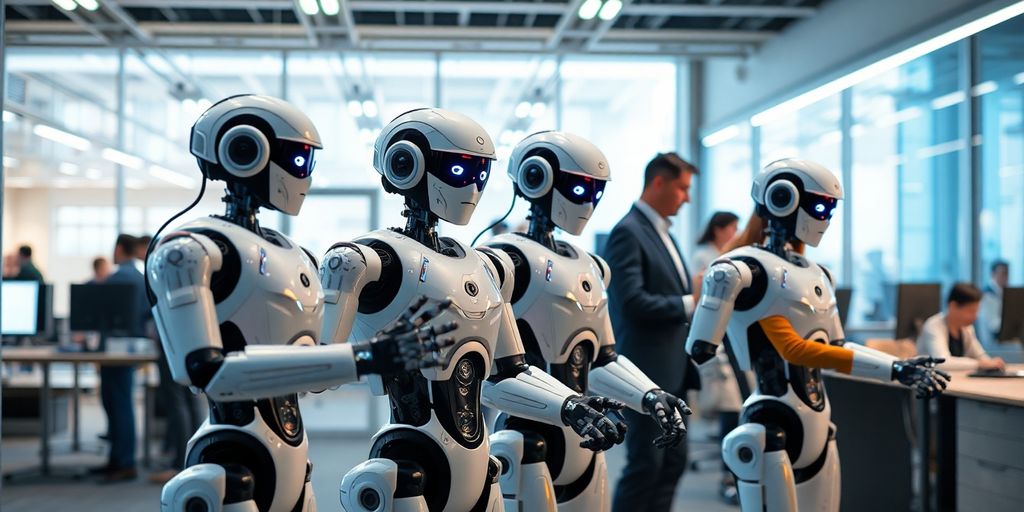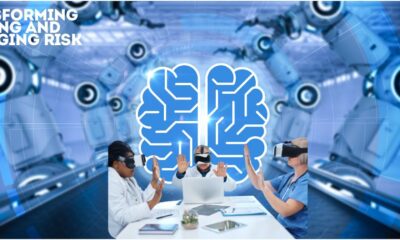Artificial Intelligence
AI-Powered Robots: Revolutionising the Workforce

The introduction of AI-powered robots into the workplace is changing how we work in many exciting ways. These intelligent machines are not just here to take over jobs; they are designed to work alongside humans, making tasks easier and more efficient. As businesses face challenges like a shortage of skilled workers, AI robots can help fill the gaps and improve productivity. This article explores how these robots are transforming various industries, enhancing safety, and addressing ethical concerns while paving the way for a new future of work.
Key Takeaways
- AI robots boost productivity by taking over repetitive tasks, allowing workers to focus on more important work.
- They are changing job roles, making some jobs easier while creating new opportunities in technology and management.
- Industries like healthcare, manufacturing, and retail are seeing significant benefits from using AI robots.
- AI robots help improve workplace safety by handling dangerous tasks and monitoring risks.
- While there are concerns about job loss, AI robots also create chances for workers to learn new skills and adapt to new roles.
The Role of AI-Powered Robots in Modern Workplaces
AI-powered robots are becoming essential in today’s workplaces, helping to boost productivity and improve overall efficiency. These robots can take over repetitive tasks, allowing human workers to focus on more complex and creative activities. This shift not only enhances job satisfaction but also optimises the use of human skills.
Enhancing Productivity and Efficiency
- Automation of Repetitive Tasks: Robots can handle mundane tasks, freeing up employees for more valuable work.
- Real-Time Data Analysis: AI can process large amounts of data quickly, providing insights that help in decision-making.
- 24/7 Operation: Unlike humans, robots can work around the clock without breaks, increasing output.
Transforming Job Roles and Responsibilities
The introduction of AI-powered robots is changing the nature of many jobs. Workers are now required to:
- Collaborate with robots to enhance productivity.
- Develop new skills to manage and maintain robotic systems.
- Focus on tasks that require human creativity and emotional intelligence.
Reducing Operational Costs
Implementing AI-powered robots can lead to significant cost savings for businesses. By automating tasks, companies can:
- Decrease labour costs by reducing the need for manual labour.
- Minimise errors and waste, leading to more efficient operations.
- Improve safety, which can lower insurance and liability costs.
The integration of robotic technologies, particularly when AI-powered, promises to boost productivity, increase workplace safety, alleviate task monotony, and reduce physical strain on workers.
In summary, AI-powered robots are not just tools; they are partners in the workplace, helping to create a more efficient, safe, and satisfying work environment.
Key Industries Benefiting from AI-Powered Robots
AI-powered robots are making a significant impact across various sectors, enhancing operations and driving innovation. These technologies are reshaping industries by improving efficiency and productivity.
Healthcare Innovations
- AI algorithms assist in diagnosing diseases by analysing medical images.
- Virtual assistants provide personalised support to patients, improving access to healthcare.
- Predictive analytics help in managing patient care and optimising treatment plans.
Manufacturing Advancements
- Robots equipped with AI can perform complex tasks with high precision.
- Predictive maintenance reduces downtime by anticipating equipment failures.
- Automation of assembly lines allows human workers to focus on quality control.
Retail and Customer Service
- AI chatbots enhance customer interactions by providing instant responses.
- Data analysis helps businesses understand customer preferences and tailor services.
- Personalised marketing campaigns are driven by insights gained from customer data.
The integration of AI in these industries not only boosts productivity but also opens up new avenues for growth and innovation.
| Industry | Key Benefits |
|---|---|
| Healthcare | Improved diagnostics, patient support |
| Manufacturing | Enhanced precision, reduced downtime |
| Retail | Personalised experiences, better customer service |
In summary, AI-powered robots are revolutionising key industries, making processes more efficient and enhancing overall performance.
Addressing the Skills Gap with AI-Powered Robots
AI-powered robots are changing how we work, especially when it comes to filling the skills gap in various industries. These robots can help workers learn new skills and adapt to changing job demands.
Upskilling and Reskilling Initiatives
- Companies are investing in training programmes to help employees learn how to work alongside robots.
- Workshops and online courses are being offered to teach new skills that complement robotic technology.
- Partnerships with educational institutions are being formed to create tailored training programmes.
Collaborative Human-Robot Work Environments
- Robots can take over repetitive tasks, allowing humans to focus on more complex work.
- This collaboration can lead to a more engaged workforce, as employees can use their creativity and problem-solving skills.
- Human oversight is essential to ensure robots are used effectively and safely.
Educational Programmes and Training
- Schools and universities are introducing robotics and AI into their curriculums.
- Training in technology-related fields is becoming more important to prepare students for future jobs.
- Continuous learning is encouraged to keep up with advancements in AI and robotics.
The integration of AI-powered robots in the workplace not only enhances productivity but also opens up new opportunities for workers to grow and develop their skills.
In summary, AI-powered robots are not just tools; they are partners in the workforce, helping to bridge the skills gap and prepare employees for the future of work. By embracing these technologies, we can create a more skilled and adaptable workforce.
AI-Powered Robots and Workplace Safety
Automating Hazardous Tasks
AI-powered robots are increasingly used to handle dangerous tasks in various industries. By taking over jobs that are risky for humans, these robots help to reduce the chances of workplace injuries. For example:
- Heavy lifting: Robots can lift and move heavy items, which lowers the risk of musculoskeletal injuries.
- Hazardous environments: Robots can operate in areas with toxic substances, keeping human workers safe.
- Repetitive tasks: Automating repetitive jobs can prevent fatigue and reduce errors.
Monitoring and Predicting Risks
AI technology can also monitor workplace conditions and predict potential hazards. This includes:
- Real-time monitoring: Sensors can track environmental conditions and alert workers to dangers.
- Risk assessment: AI can analyse data to identify patterns that may lead to accidents.
- Preventive measures: Recommendations can be made to improve safety protocols based on AI analysis.
Enhancing Ergonomics and Reducing Injuries
By providing ergonomic recommendations, AI-powered robots can help create a safer work environment. This includes:
- Adjustable workstations: Robots can suggest optimal workstation setups to prevent strain.
- Feedback systems: Continuous feedback can help workers maintain proper posture.
- Training simulations: AI can create virtual training environments for workers to practise safety procedures.
The integration of AI in workplace safety not only protects employees but also enhances overall productivity. By reducing risks, companies can focus on growth and innovation.
The Ethical Implications of AI-Powered Robots
Ensuring Fairness and Inclusivity
The rise of AI-powered robots brings up important questions about fairness and inclusivity. Companies must ensure that these technologies do not favour one group over another. This can be achieved by:
- Implementing diverse teams in AI development.
- Regularly auditing AI systems for bias.
- Engaging with communities to understand their needs.
Preventing Job Displacement
As robots take on more tasks, there is a real concern about job loss. To address this, businesses should:
- Invest in training programmes for employees.
- Create new roles that work alongside robots.
- Promote a culture of lifelong learning.
Addressing Bias and Discrimination
AI systems can unintentionally perpetuate existing biases. To combat this, organisations should:
- Use diverse datasets for training AI.
- Monitor AI decisions for fairness.
- Foster transparency in AI processes.
The ethical responsibility of companies is crucial as AI becomes more integrated into our lives. Transparency and accountability are key to ensuring that AI serves everyone fairly and justly.
Challenges in Implementing AI-Powered Robots
The integration of AI-powered robots into workplaces presents several significant challenges that organisations must navigate. These hurdles can impact the successful adoption of robotic technologies and their effectiveness in enhancing productivity.
Technical and Operational Hurdles
- Complex Programming: Programming robots can be intricate and often requires specialised knowledge that not all companies possess.
- Task Limitations: Not every job can be automated, especially those needing human-like coordination and judgement.
- Integration Issues: Merging new robotic systems with existing processes can lead to disruptions and inefficiencies.
Cost and Investment Considerations
- High Initial Costs: The upfront investment for AI and robotics can be substantial, making it a barrier for smaller businesses.
- Ongoing Maintenance: Regular upkeep and updates are necessary to keep robots functioning optimally, adding to long-term costs.
- Return on Investment: Companies may struggle to see immediate financial benefits, leading to hesitance in adopting these technologies.
Regulatory and Compliance Issues
- Legal Frameworks: The lack of clear regulations surrounding AI and robotics can create uncertainty for businesses.
- Safety Standards: Ensuring that robots meet safety requirements is crucial, but can be challenging to navigate.
- Data Privacy: With AI systems collecting vast amounts of data, companies must ensure compliance with data protection laws.
The risks of falling behind: challenges faced by companies not adapting to AI and robotics include loss of competitive edge, increased operational costs, and more.
In conclusion, while AI-powered robots offer numerous advantages, addressing these challenges is essential for successful implementation. Companies must be proactive in overcoming these obstacles to fully harness the potential of robotic technologies in the workforce.
AI-Powered Robots in Customer Service
Improving Response Times
AI-powered robots, such as chatbots and virtual assistants, are changing the way businesses handle customer service. These systems can provide instant answers, which helps reduce waiting times for customers. For example, a chatbot can handle multiple inquiries at once, ensuring that customers receive timely assistance.
Personalising Customer Interactions
AI technology allows businesses to tailor their interactions with customers. By analysing customer data, AI can:
- Offer personalised recommendations based on previous purchases.
- Send targeted marketing messages that resonate with individual preferences.
- Anticipate customer needs, making interactions smoother and more relevant.
Analysing Customer Data
AI can sift through vast amounts of data to identify trends and patterns. This capability enables businesses to:
- Understand customer behaviour better.
- Adjust their strategies based on real-time insights.
- Improve overall service quality by addressing common issues.
By integrating AI into customer service, companies can not only enhance efficiency but also create a more engaging experience for their customers.
In summary, AI-powered robots are revolutionising customer service by improving response times, personalising interactions, and providing valuable insights through data analysis. This shift not only benefits businesses but also leads to a more satisfying experience for customers.
The Future of AI-Powered Robots in the Workforce
Emerging Trends and Technologies
The future of AI-powered robots is bright, with innovations that will change how we work. Here are some key trends to watch:
- Increased Automation: More tasks will be automated, allowing humans to focus on complex problems.
- Human-Robot Collaboration: Robots will work alongside humans, enhancing productivity and efficiency.
- Advanced AI Capabilities: Robots will become smarter, learning from their environments and improving over time.
Long-Term Economic Impacts
The economic landscape will shift significantly due to AI-powered robots. Some potential impacts include:
- Job Creation: New roles will emerge in tech and robot maintenance.
- Increased Productivity: Businesses will operate more efficiently, leading to growth.
- Cost Savings: Companies will save on labour costs, which can be reinvested into innovation.
Potential for Global Workforce Transformation
As robots become more integrated into the workforce, we may see a global shift in job dynamics. This transformation could lead to:
- New Job Markets: Industries will evolve, creating opportunities in sectors we can’t yet imagine.
- Skill Development: Workers will need to adapt, leading to a focus on upskilling and reskilling.
- Enhanced Work-Life Balance: With robots handling repetitive tasks, employees may enjoy more flexible working conditions.
The rise of robots that act and think more like people can integrate better into the workforce and bring a level of efficiency unmatched by human employees.
In conclusion, the future of AI-powered robots in the workforce promises to be transformative, offering both challenges and opportunities for workers and businesses alike.
AI-Powered Robots and Employee Well-Being

Reducing Work-Related Stress
AI-powered robots can significantly reduce work-related stress by taking over repetitive and physically demanding tasks. This allows employees to focus on more engaging and fulfilling work. Here are some ways robots contribute to employee well-being:
- Task Automation: Robots handle mundane tasks, freeing up time for creative and strategic thinking.
- Improved Work Environment: By managing hazardous tasks, robots create a safer workplace.
- Enhanced Job Satisfaction: Employees can engage in roles that require human skills, leading to greater job satisfaction.
Promoting Mental Health
The integration of AI-powered robots can also promote mental health in the workplace. By alleviating the burden of monotonous tasks, employees can experience:
- Increased Motivation: Engaging in meaningful work boosts morale.
- Better Work-Life Balance: Automation allows for more flexible working hours.
- Reduced Burnout: With less stress from repetitive tasks, employees are less likely to experience burnout.
Balancing Human and Machine Collaboration
A successful collaboration between humans and robots is essential for a healthy work environment. Key aspects include:
- Training and Support: Providing employees with the necessary training to work alongside robots.
- Open Communication: Encouraging discussions about the role of robots in the workplace.
- Feedback Mechanisms: Implementing systems for employees to share their experiences and concerns regarding AI integration.
The future of work lies in collaboration between humans and AI, where both can thrive together, enhancing overall well-being.
AI-Powered Robots in Legal Services
Automating Legal Research
AI-powered robots are changing how legal research is done. They can quickly sift through vast amounts of legal documents, helping lawyers find relevant cases and information faster than ever. This technology saves time and improves accuracy, allowing legal professionals to focus on more complex tasks.
Streamlining Contract Analysis
One of the most significant benefits of AI in legal services is in contract analysis and management. AI tools can analyse contracts, identifying key clauses, potential risks, and ensuring compliance with legal standards. This not only speeds up the process but also reduces the chances of human error.
Enhancing Document Review Processes
AI can also assist in reviewing documents. By using machine learning, these systems can highlight important information and flag inconsistencies. This leads to a more efficient review process, allowing lawyers to handle larger volumes of work without compromising quality.
Key Benefits of AI in Legal Services
- Increased Efficiency: Tasks that once took hours can now be completed in minutes.
- Cost Reduction: Automating routine tasks can lower operational costs for law firms.
- Improved Accuracy: AI reduces the risk of human error in legal documentation.
The integration of AI in legal services is not just about replacing human effort; it’s about enhancing the capabilities of legal professionals, allowing them to provide better service to their clients.
AI-Powered Robots and Data Analysis
Gaining Operational Insights
AI-powered robots are changing how businesses understand their operations. By analysing large amounts of data, these robots can help companies see patterns and trends that humans might miss. This leads to better decision-making and improved performance. For example, AI can look at sales data to find out what products are popular and when customers are most likely to buy them.
Supporting Strategic Decision-Making
With AI, businesses can make smarter choices. Here are some ways AI helps:
- Identifying risks: AI can spot potential problems before they happen.
- Predicting trends: It can forecast future market changes based on past data.
- Optimising resources: AI helps in using materials and staff more efficiently.
Driving Innovation Through Data
AI not only helps in understanding current data but also drives new ideas. By using advanced data analysis, companies can:
- Discover new market opportunities.
- Create products that meet customer needs better.
- Improve existing services based on customer feedback.
AI’s ability to process vast amounts of data is crucial for businesses aiming to stay competitive in today’s fast-paced world.
In summary, AI-powered robots are essential for gaining insights, making informed decisions, and driving innovation in the workplace. They help businesses not just to keep up but to lead in their industries, ensuring they are always a step ahead of the competition.
Public Perception of AI-Powered Robots
Optimism and Enthusiasm
Many people are excited about the potential of AI-powered robots. They believe these machines can make work easier and more efficient. Surveys show that a significant portion of the public is optimistic about the benefits of AI in the workplace. This enthusiasm is often driven by the idea that robots can handle repetitive tasks, allowing humans to focus on more creative and complex work.
Concerns About Job Security
Despite the excitement, there are also worries about job security. Many individuals fear that robots will take over their jobs, leading to unemployment. Some key concerns include:
- Job displacement: Workers in certain industries may lose their jobs to automation.
- Skill gaps: Not everyone has the skills needed to work alongside robots.
- Economic inequality: There is a fear that automation could widen the gap between rich and poor.
The Need for Transparent Communication
To address these concerns, it is crucial for companies and governments to communicate openly about the role of AI in the workforce. This includes:
- Educating the public about how AI can complement human work.
- Providing training programmes to help workers adapt to new technologies.
- Engaging in discussions about the ethical implications of AI.
Understanding public perceptions and acceptance of artificial intelligence is essential for its successful integration into society.
In conclusion, while there is a mix of optimism and concern regarding AI-powered robots, clear communication and education can help bridge the gap between these two perspectives.
Conclusion
In summary, AI-powered robots are changing the way we work in many exciting ways. They help us by taking over boring and repetitive tasks, which allows workers to focus on more interesting and creative jobs. While there are worries about job loss, it’s important to remember that these robots are meant to work alongside humans, not replace them. As we embrace this new technology, we must also think about how to support workers in learning new skills. By doing this, we can ensure that everyone benefits from the advantages of AI and robots, leading to a brighter future for all.
Frequently Asked Questions
What are AI-powered robots and how do they work?
AI-powered robots are machines that use artificial intelligence to perform tasks. They can learn from their environment and make decisions based on data, helping them to work more efficiently.
How can AI robots enhance productivity in workplaces?
AI robots can take over repetitive tasks, allowing human workers to focus on more complex jobs. This can lead to faster work and better results.
Will AI robots replace human jobs?
While AI robots can automate some jobs, they are more likely to work alongside humans, helping them with tasks rather than completely replacing them.
What industries are benefiting from AI-powered robots?
Industries like healthcare, manufacturing, and retail are seeing great benefits from AI robots, as they help improve efficiency and service.
How do AI robots improve workplace safety?
AI robots can perform dangerous tasks, reducing the risk of injury for human workers. They can also monitor environments for potential hazards.
What are the ethical concerns regarding AI robots?
Concerns include job displacement, fairness in how robots are used, and the potential for bias in AI decision-making.
How can companies prepare their workforce for AI integration?
Companies can offer training programmes to help workers learn new skills that complement AI technologies, ensuring they remain valuable in a changing job market.
What is the future of AI robots in the workforce?
The future looks promising, with AI robots expected to play a larger role in various industries, enhancing productivity and creating new job opportunities.
-

 Press Release7 days ago
Press Release7 days agoCrypto WINNAZ Launches First On-Chain Yield Engine for Meme Coins, Enabling 20x–300x Returns
-

 Press Release4 days ago
Press Release4 days agoBellarium ($BEL) Price Prediction: Could It Hit $5 by 2026?
-

 Press Release1 day ago
Press Release1 day agoClinical Trials Market Set for Robust Growth, Driven by Drug Development Surge and Digital Innovation
-

 Business3 days ago
Business3 days agoHow Managed IT Solutions Help Small Teams Compete at Enterprise Scale
-

 Press Release2 days ago
Press Release2 days agoFill-Finish Pharmaceutical Contract Manufacturing Market Expected to Flourish Amid Biopharmaceutical Boom and Global Outsourcing Trend by 2035
-

 Press Release2 days ago
Press Release2 days agoPreventive Vaccines Market to Witness Strong Growth by 2035
-

 Press Release2 days ago
Press Release2 days agoGreen Bio Chemicals Market Poised for Sustainable Growth amidst Global Shift to Eco-Friendly Alternatives by 2035
-

 Press Release2 days ago
Press Release2 days agoIndustrial Boiler Market Expected to Surpass USD 24.4 Billion by 2035 Amid Growing Demand for Energy Efficiency and Industrialization






























